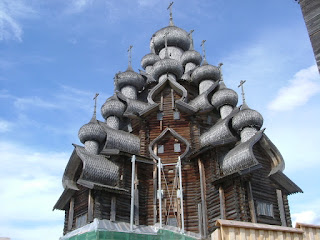6/5/10
Kizhi Island is an island
museum of wooden structures built largely during the early eighteenth century.
Because of long periods of freezing cold during northern Russian winters, the
wood is less prone to rot by mold and destruction by burrowing insects. So many of these
buildings are still standing and still structurally sound. I saw examples of the
same phenomenon in the wooden churches (Stavekirke) of the Norwegian countryside on a trip I
took with my mother in 1976.
 |
| Ancient wooden church complex on Kizhi Island under repair |
 |
| The church complex on Kizhi Island, viewed form the farmhouse |
We did go into the “winter church” (Church of the Intercession, 1764), which contained many icons, and we were allowed to take photos inside. A bell tower stood at one point of a triangle with the other two
churches. The complex of the three buildings offered endless combinations
of views and photographic variety, each more interesting or pleasing than the
last, particularly with the constantly changing background of clouds—cirrus and
cumulus—against an intensely blue sky.
 |
| Icons inside the Church of the Intercession |
 |
| Extraordinary wooden cupolas of the Church of Transfiguration |
As a part of the outdoor
museum complex, there was a large, old farmhouse, transported to the site from
elsewhere, and appointed as a typical pre-communist peasant farmhouse, with a
windmill and several other buildings like granaries and animal sheds. Apparently, many farm animals were kept in the house, especially during winter.
 |
| Farm house museum, Kizhi Island |
When we
awoke this morning, we were docked at Petrozavodsk, on the western shore of Lake Onega. Both
Kizhi and Petrozavodsk are located in the Republic of Karelia, the northernmost
republic in European Russia. Many Karelians are Finns in origin and speak a
Finno-Ugric language.
The city of Petrozavodsk
was originally a foundry city, making heavy metal instruments of war (cannon,
etc.) as well as rails and other heavy railway equipment.
 |
| Cannon and cog wheel from old foundry in Petrozavodsk |
The city was largely
destroyed during “The Great Patriotic War” (WWII) and was rebuilt afterwards in
the Soviet style. According to our guide, Natasha, the city has hardly changed since the collapse of the USSR. So it’s still a model of the life and
architecture of Soviet times, except that now more food is available in the little
local market.
 |
| Alexander Nevsky Cathedral, Petrozavodsk |
We visited a beautiful
church, Alexander Nevsky Cathedral, where a baptism was being held. So I couldn't photograph the inside, which was exquisite. The color
of the inside walls was the most beautiful light green-blue that I think I’ve
ever seen. Someone called it “mint green,” but it was a richer color than that.
It was absolutely luscious, peaceful, awesome/awe-inspiring. And the dome above
was a contrasting dark blue. The icons were modest and there was not too much
glitter in the church. I lit a candle for the girls, and I didn’t really want
to leave the sanctuary when it was time to go.
 |
| Kvas for sale in the market |
We visited other sites in
the city, including a market, where we were able to purchase a few items. Another major site in the city is a central square where an eternal flame continues to burn for the defenders of Petrozavodsk during WWII. There, we saw a wedding party get out of a limousine, and the bride and groom put flowers
beside the flame. She had on a pretty flimsy dress and must have been very
cold!
 |
| Wedding bouquets at the flame of eternal remembrance |
A statue of Lenin towered over the main city square, cap in hand, leaning
toward the future.
 |
| Lenin in the main square of Petrozavodsk |
We're now sailing back southward on Lake Onega from Petrozavodsk toward the Svir River. The lake is a dark gray-blue, and clouds hanging over the north and east are ominous. Yet off to the west, the sky seems ordinary—calm, almost nonchalant. Today, in Petrozavodsk, the weather was fierce and cold—the cold of an unforgiving north country—windy, intermittent rain. Our guide (since Kiev) is Natasha, whose home town is Petrozavodsk, and she served as our town guide today. Petrozavodsk is such a contrast to Kizhi Island, in the middle of Lake Onega, which we visited yesterday.
A rainbow beams between clouds and lake outside
the window near where I’m sitting and writing. I took some photos
with both cameras but don’t know how they’ll come out.
 |
| Rainbow over Lake Onega |
This afternoon, we had an
optional trip into town to see and hear a group called “Kantele” that played
traditional Karelian instruments and sang and danced. They were a great
pleasure to watch and listen to—lively music and energetic dancing. Also, three
women played an instrument that looks like an autoharp, also called a kantele,
that had a sweet, ringing sound—rather like a harp, but more crisp and
high-pitched. One of the singers was tall, and her face reminded me of my
mother when she was young.

No comments:
Post a Comment